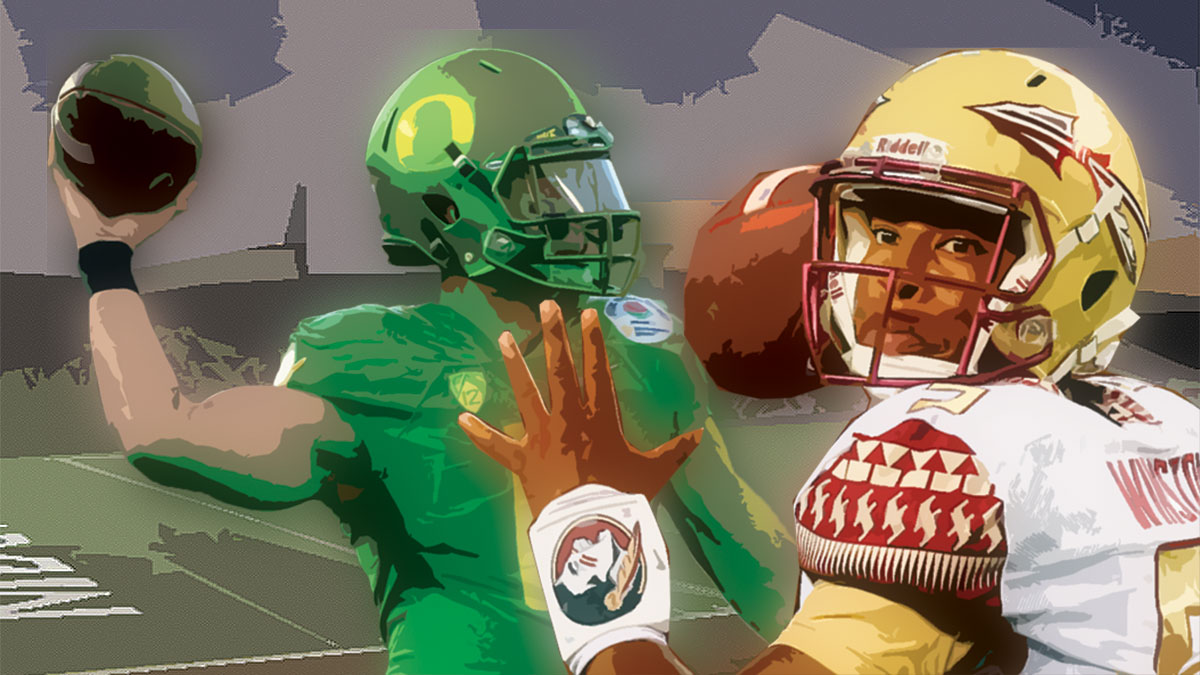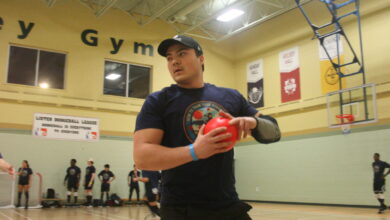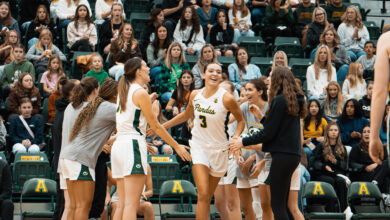The winners and losers of the NFL Draft
 Supplied
SuppliedBest picks:
Round 1, Pick 6. Leonard Williams DE, USC (HOU): Anytime the highest rated player in the draft slips, they’re bound to be labeled a “best pick.” No, the Jets didn’t necessarily need another defensive lineman with Muhammad Wilkerson and Sheldon Richardson on the roster, but Williams’ value was too good to pass up at this point in the draft. Even if Wilkerson isn’t moved, it’s not a stretch to think the three of them can share the field in a 4–3 defence. New general manager Mike Maccagan exemplified the best-player-available strategy instead of reaching for need at running back (Todd Gurley, anyone?), and other front offices should take note. Drafting Williams also gives the Jets great flexibility if they do have to trade one of their studs for help at Sam or offensive line.
Round 1, Pick 32. Malcolm Brown DT, Texas (NE): He’s not Vince Wilfork, but he’ll do. If Brown were drafted higher, he would’ve been pegged as a savvy, bold pick. If he were drafted any later, he would’ve been labeled more of a steal than he already was. Brown, 320 pounds, was an absolute juggernaut at Texas and should make a smooth transition into the NFL where he’ll be a force on the line of scrimmage. The Patriots couldn’t have asked for a better scheme fit at a position of need.
Round 3, Pick 70. Jaelen Strong WR, Arizona St. (HOU): This year’s group of pass-catcher’s isn’t as deep as 2014’s, but Jaelen Strong coming off the board as the 10th wideout is pure value. After Amari Cooper and Kevin White, every team’s draft board seemed to vary greatly, but it’s still no excuse to let Strong — who we graded as a first-rounder — to fall to the third. He’ll complement current Texans deep threat DeAndre Hopkins nicely following Andre Johnson’s departure.
Worst Picks:
Round 1, Pick 25. Shaq Thompson LB, Washington (CAR): The definition of a reach. True, the Panthers didn’t own a third-round pick this year, but Thompson might have been available at their pick in the second. Thompson’s a big, versatile linebacker who can play offence or defence, but Cam Newton needs serious help on the offensive line, which was neglected by the Panthers until the fourth round. This year’s draft is shallow, but Shaq Thompson-like players are a dime a dozen.
Round 2, Pick 46. Jaquiski Tartt S, Samford (SF): The 49ers needed help on defence after being decimated by Patrick Willis and Chris Borland’s surprise retirements, but Tartt isn’t the answer. Eric Reid and Antoine Bethea make up one of the stronger positions in the 49er locker room, so reaching on Tartt doesn’t make sense, especially since they don’t need another safety. He doesn’t have the size to slide over to cornerback, which is where the 49ers really need help on the secondary. Linebacker should have been prioritized instead of reaching on a guy nobody’s heard of from a college who nobody’s head of, either.
Round 2, Pick 40. Dorial Green-Beckham WR, Missouri (TEN): Funny, because I thought DGB would make our “best picks” list before the draft. He’s an immense talent, who was regarded as the No. 1 overall high school recruit in 2012, but DGB’s off-field issues are hard to ignore. He might have been better suited on a team where he would be surrounded by wise veterans and an older WR who could serve as a mentor. But in Tennessee, DGB seems to be the WR1 the Titans want for new QB Marcus Mariota. Feels like Kenny Britt all over again. See how that turned out, Titans fans? DGB is more of a question mark than a bad pick at this point, but the situation in Tennessee is less than ideal for a seemingly troubled, young wide receiver.
Best Drafts:
New York Jets: The Jets were lucky to have USC Trojan Leonard Williams slip to them at the sixth pick, but they still had a strong draft when looking at rounds two through seven. Ohio State’s Devin Smith went a tad higher than expected, especially with Jaelen Strong still on the board, but he’s got elite breakaway speed and can play outside or in the slot. He’s a nice WR3 to insert next to Brandon Marshall and Eric Decker, but the real question is whose going to throw to them? Ryan Fitzpatrick is expected to beat Geno Smith in training camp, but fourth-round pick Bryce Petty could nestle himself into the backup quarterback role as early as this season. While Petty won’t start immediately, the Jets didn’t have to reach on one of their most desperate needs. One of our favourite moves was flipping seventh round pick for disgruntled Rams RB3 Zac Stacy. Stacy’s fumbles caused him to plummet down the Rams’ depth chart, but he was a bell cow and goal-line machine just one year ago. He’s definitely better than any running back available in the seventh round.
Chicago Bears: Kevin White wasn’t exactly a steal at the seventh pick, but he might have the highest ceiling of any receiver or offensive player in the draft. While Bears whipping boy Jay Cutler continues to struggle, White is expected to contribute right away opposite Alshon Jeffery. Losing reception machine Brandon Marshall to the Jets doesn’t look so bad anymore. Cutler also got some help up front, as Oregon Duck C Hroniss Grasu was one of our favourite picks. Grasu will likely sit behind Will Montgomery to start the season, but could push for a starting position throughout the year. With Matt Forte nearing 30 years of age, Jeremy Langford gives the Bears some firm depth in the backfield. The Bears also addressed the defensive line in the second round with former Florida State Seminole Eddie Goldman. Goldman isn’t the pass-rusher the Bears covet, but he’s an excellent against the run in a division where they’ll see Eddie Lacy, Joique Bell and potentially Adrian Peterson twice a year.
Pittsburgh Steelers: Bud Dupree seemed to be the main beneficiary of Shane Ray and Randy Gregory’s off-field issues, yet still lasted till the 22nd pick. Dupree’s jaw-dropping first-step as an edge-rusher will add an explosive element to last year’s sixth-best rushing defence. Also bolstering the Steelers defence will be former Ole Miss Rebel Senquez Golson, who totaled a whopping 10 interceptions last season. Golson didn’t lead the nation in interceptions, but seventh-rounder Gerod Holliman did. Also joining Holliman and Golson will be fourth round pick Doran Grant who adds solid depth in a new-look Steelers secondary. On the other side of the ball, Sammie Coates, who we thought might be overrated on some draft boards, hit the “just right” spot in the third round. Antonio Brown is obviously the go-to guy in Pittsburgh, but Coates, Markus Wheaton and Martavis Bryant make a promising, young WR corps.
Worst Drafts:
Carolina Panthers: Not only did the Panthers skip drafting an offensive lineman in the first round, by far their biggest need, they waited until the fourth round before addressing it. Shaq Thompson is a nice player, but a similar OLB, if not Thompson himself, could have been available in the second or third round. Devin Funchess adds some size to the Cam Newton’s targets, but he’s like a watered down version of Panthers current WR1 Kelvin Benjamin. Jaelen Strong was still on the board and would have added some punch to an otherwise stale passing offence. It’s hard to see Funchess contributing right away. Daryl Williams is merely OK, and it’s not realistic to think he’s the solution to the Panthers woes on the offensive line. Cameron Artis-Payne adds RB depth with DeAngelo Williams’ departure, but that’s just one of the only highlights from the Panthers 2015 draft.
Buffalo Bills: The Bills weren’t going to get a franchise QB in this year’s draft, so let’s not punish them too hard for that one. Whoever starts at QB next season is going to benefit from having a target like Sammy Watkins, but it left the Bills without a first round pick in 2015. It’s difficult to completely nail the draft without a first rounder, but the Bills had a poor draft regardless. Ronald Darby could’ve been had two rounds later, and while Stephon Gilmore and Leodis McKelvin aren’t Pro-Bowlers the Bills are just fine at CB. Current Bills RB2 Fred Jackson is 34 years old, so adding backfield depth with Karlos Williams makes sense, but once again, Williams could have been drafted in the sixth or even seventh round. The Bills weren’t shooting for value, which would’ve made sense if it was for the sake of need. But glaring holes at LB and S and a several questionable picks give the Bills one of the weakest classes of 2015.
Arizona Cardinals: Star Wisconsin RB Melvin Gordon seemed destined for the Cardinals, who desperately needed a talented bell cow to overtake Andre Ellington. But once Todd Gurley was unexpectedly drafted to the Rams at the 10th pick, the Cardinals never had a chance to patch up their run game in the first round. The Cardinals were forced to wait until the third round to take a running back in David Johnson. Johnson possesses a potent pass-catching game out of the backfield, but our fifth-ranked running back Duke Johnson was still on the board. Although there was a steep drop off in talent after Gurley and Gordon, Duke graded higher in potential and first-year impact probabilities when compared to David. D.J. Humphries in the second round doesn’t get us excited, and the Cardinals might have been better suited to take a pass-rusher like the risky Randy Gregory. Instead, the Cardinals took Mizzou edge-rusher Markus Golden, who was overshadowed by teammate Shane Ray, on day 2. Golden is a nice addition to the Cardinals, but pressing needs at linebacker should have been addressed sooner.




